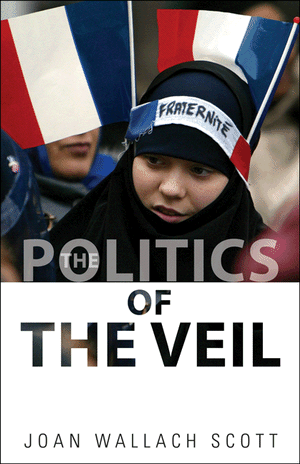3. How does the
author come to the conclusion that “rather than resolving the problem of
integrating Muslims into French society, the law banning headscarves has
exacerbated it”? (179)
The law
passed by the French government that bans the wearing of religious affiliated
signs is aimed towards larger, more noticeable displays of religion. This law is to make sure the state and
religion remain separated. The
Politics of the Veil discusses that small, discreet religious signs like
small crosses or small Korans are acceptable, but more noticeable signs like
large crosses or turbans are banned.
This regulation is believed to mainly target Muslim girls wearing
headscarves.
This law is
supposed to unite the entire French community.
The headscarf, known more commonly as a veil, is abrasive to French
customs. For this reason, the society is
attempting to eliminate the differences to unite the people.
 |
| Artwork on a building in France showing the integration of Muslim women and their headscarves by painting them the colors of the French flag. susiesbigadventure.blogspot.com |
Joan
Wallach Scott uses examples of women being rejected from jobs or service, in
general, for wearing headscarves. Scott
quoted a woman, “The veil is a 100 percent handicap in French society.” Employers will not hire a Muslim woman who
wears a veil. Many employees will not
serve a woman wearing a veil. An example
in the text talked about the teller of a bank rejecting service to a Muslim
woman wearing a veil because of the fear of being robbed. This was the really the only example that had
any reason to reject service because of a veil, and the other instances just
damaged the human rights of these women.
Other examples included teachers refusing to interact with parents
wearing the veils just because it was “forbidden.” Even thought the Muslim woman in the example
was a mother of five and elected to the position of the delegate of the parents’
association at the school, the teachers still refused to listen to what the
woman had to say. Reasons like this are
discriminating and, no matter the law, uncalled for in any society.
The French
society is attempting to integrate the Muslim community by minimizing the
differences between the two cultures.
Joan Wallach Scott has come to this conclusion through the analysis of
the confrontations the law is causing.
Without this law in place, the Muslim woman wearing the scarf who wanted
to speak with her child’s teacher would have had little difficulty expressing
ideas to that teacher. But now that
people, like the teacher, have grounds for the discrimination they aren’t
afraid to be outspoken about it. Wearing
headscarves would typically just be a part of the normal Muslim culture that the
French society would grow to respect but with this law in place, the French
citizens are able to single out the differences between the cultures.
The law
itself does make sense. Separating the
state and religion would be helpful in integrating all French people with
different cultural backgrounds without religion interfering. This law is just not being implemented
correctly. Banning such a large part of
the Muslim culture takes away from the human rights these people deserve.
 |
| Muslim women in France protesting for their human rights. www.barenakedislam.com |
Joan Wallach
Scott makes a great point when arriving at the conclusion that this law has
done the exact opposite of integrating Muslims into the French society. If the society is encouraged to shun the
Muslim women for being different, the society will only become more separated. Turning the headscarves into a “handicap” for Muslim women makes their lives in France much more difficult.







